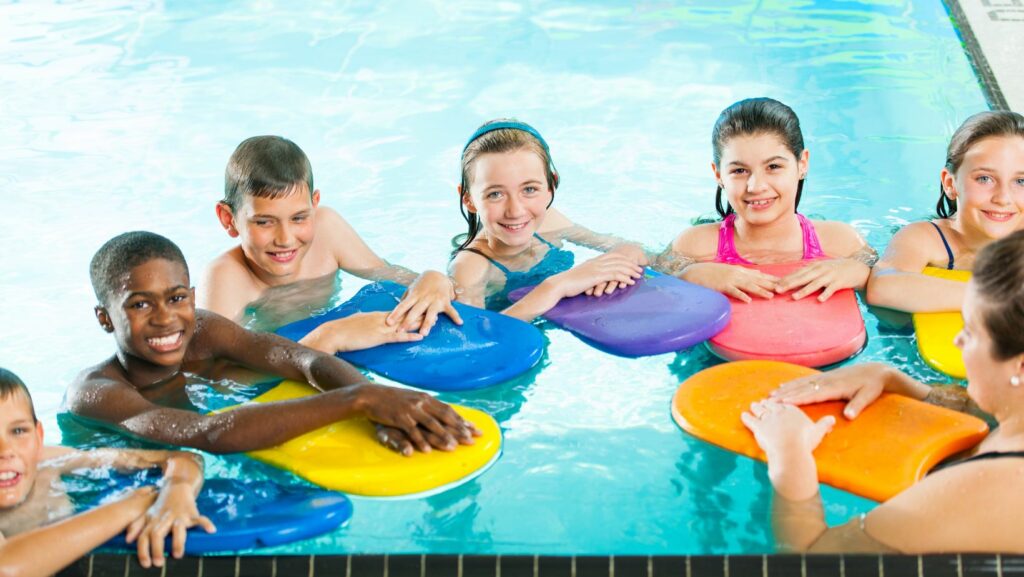There are countless benefits to swimming, however, it’s crucial to be also aware of the potential risks involved. By understanding and implementing key safety measures, parents can ensure their children have a safe and enjoyable experience in the water. From preventing accidents to promoting healthy swimming habits, these safety tips are essential for every parent and child.
How Can I Stay Safe When Swimming?
Safety in and around the water starts with awareness and preparation. Understanding the basics of water safety and instilling these habits in your children can significantly reduce the risk of accidents.
Whether you’re at the beach, a public pool, or a private swimming area, following these guidelines can help keep everyone safe. It’s important to be vigilant and educate your kids about the potential dangers associated with swimming and how they can protect themselves. By reinforcing these safety rules, you can help your children feel confident and secure in the water.
Walk, Do Not Run
One of the simplest yet most effective safety tips is to walk, not run, around the pool area. Running can lead to slips and falls, which may cause serious injuries. Encourage your children to move slowly and cautiously when near water, especially on wet or slippery surfaces.
Pool decks and surrounding areas can be slippery, and a fall can result in cuts, bruises, or even more severe injuries. Remind your kids that walking safely around the pool helps everyone have a fun and injury-free time. Setting a good example by walking yourself can reinforce this important safety habit.
Don’t Swim Alone
Adult supervision is a necessity for any children who are swimming, even if it isn’t particularly deep water. Swimming alone increases the risk of drowning, as there is no one to help in case of an emergency. Make it a rule that no one swims alone, regardless of their swimming ability. This rule applies to adults as well, as even experienced swimmers can encounter unexpected difficulties in the water. Always ensure someone knows where you are when swimming, just in case of emergencies.
Having a swimming buddy ensures that there is always someone nearby to assist in case of trouble, providing an extra layer of safety for everyone.
Don’t Drink Alcohol
For adults, avoiding alcohol when supervising children around water is crucial. Alcohol impairs judgement, slows your reaction time, and hinders your coordination, all of which can be dangerous and even fatal when mixed with an emergency in the water.
Ensure you are alert and fully capable of responding to any potential issues that may arise. It’s also important to keep alcoholic beverages away from swimming areas to prevent accidents.

By staying sober and vigilant, you can better protect your children and ensure a safe swimming experience for everyone involved. Setting a good example by avoiding alcohol around water can also teach children the importance of making safe choices.
Look Before You Leap or Dive In
Everyone loves heading to the beach, local dam or river to cool off when its hot, but it’s vital to be aware of the dangers before you dive in.
Before diving or jumping into water, always check the depth and for any hidden obstacles. This can prevent head and spinal injuries. Teach your children to always enter water feet first until they are sure it is safe to dive. Diving into shallow water or an area with hidden rocks or debris can lead to serious injuries.
Encourage your kids to take a cautious approach and to respect posted signs and warnings about water depth and diving safety. By looking before they leap, they can avoid accidents and enjoy their time in the water more safely. Reinforcing this habit helps children understand the importance of assessing their environment.
Take Smart Precautions and Use Layers of Protection
For safety around your pool area, utilise barriers such as pool fences and alarms to prevent unsupervised access to water.
Educate your children about the dangers of water and the importance of swimming in designated areas. Learning to swim can be a lifesaving skill, especially in the case of an emergency. To help protect your children, you can enrol them in learn to Swim classes to build their confidence and skills in the water.
Layering safety measures, such as using life jackets and keeping rescue equipment nearby, adds extra protection. By taking these precautions, you can significantly reduce the risk of accidents and ensure a safer swimming environment for your children. Combining education with physical safety measures creates a comprehensive approach to swimming safety.
Use Sunscreen
Whether at the beach or the local pool, you should always be sun safe! Protect your children’s skin from harmful UV rays by applying sunscreen regularly. Choose a water-resistant sunscreen and reapply it every two hours or after swimming. Sunburn can occur even on cloudy days, so make sunscreen a part of your routine.
In addition to sunscreen, encourage your children to wear protective clothing, such as rash guards and hats, to further shield their skin from the sun. Staying in the shade during peak sunlight hours can also help prevent sunburn and reduce the risk of skin damage. Remember to always Slip, Slop, Slap, Seek, and Slide!
Know Your Limits
Lastly, you need to know your limits! You can teach your children to recognise their own swimming limits so they can tell when they need a break.
Encourage them to take breaks when needed and avoid pushing themselves too hard. It’s important for them to understand that it’s okay to take a rest and enjoy the water at their own pace.

Recognising when they are tired, dehydrated, or feeling unwell can prevent accidents and ensure a positive swimming experience. By listening to their bodies and knowing their limits, your children can stay safer when in and around water.
Key Takeaways
Swimming is a wonderful activity, but it comes with its own set of risks. By following these safety tips such as; walking instead of running, swimming with a buddy, avoiding alcohol, checking the water before diving, using layers of protection, applying sunscreen, and knowing your limits, you can ensure a safe and enjoyable swimming experience for your children.
Ensure your child has the skills they need when in or around water and enrol them in swimming lessons at your local Rackley Swimming centre. Give your child the opportunity to learn lifesaving skills, and not to mention have some fun in the water!
Be vigilant around the water and ensure your next swimming adventure is a safe one!

